
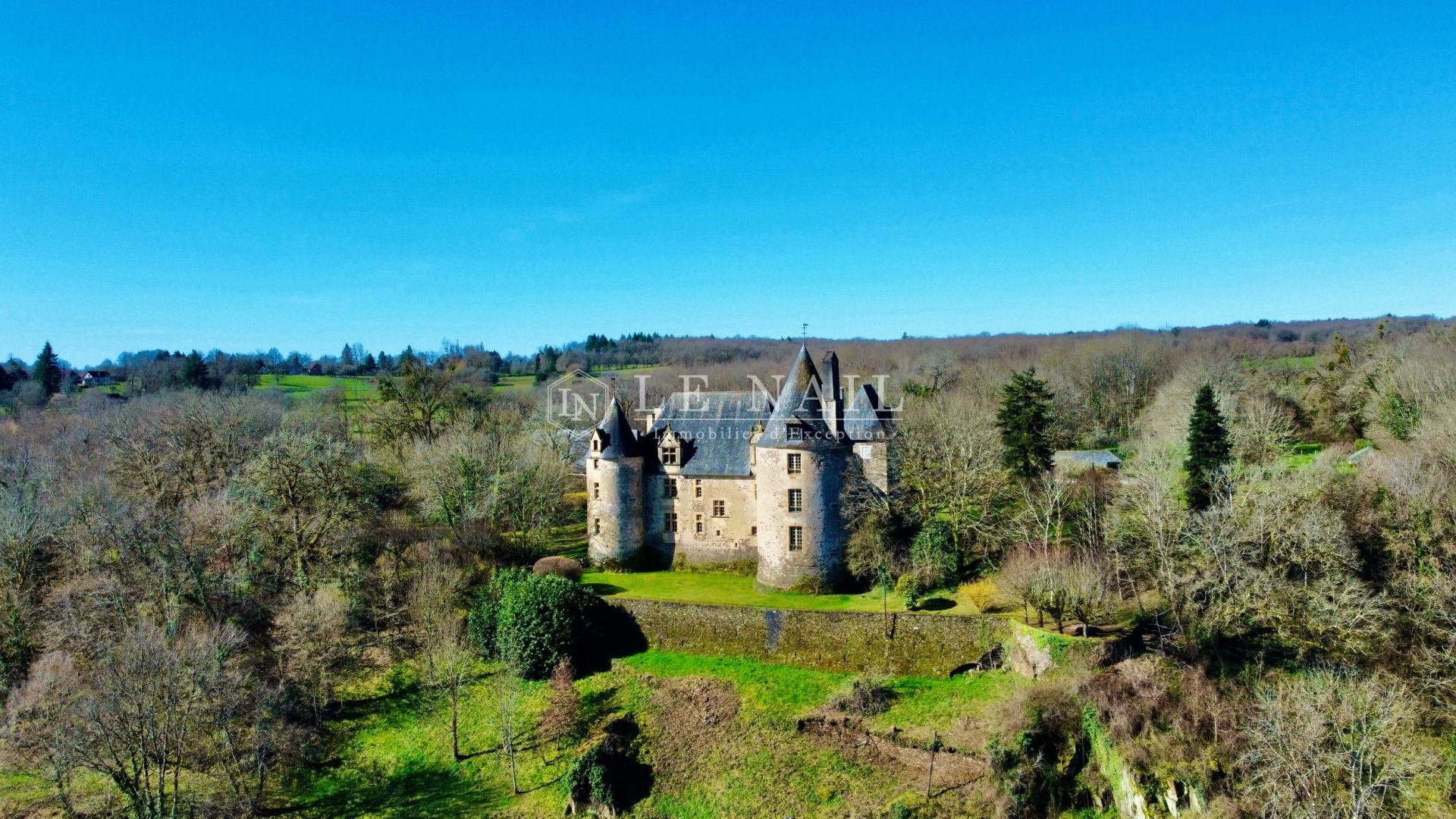

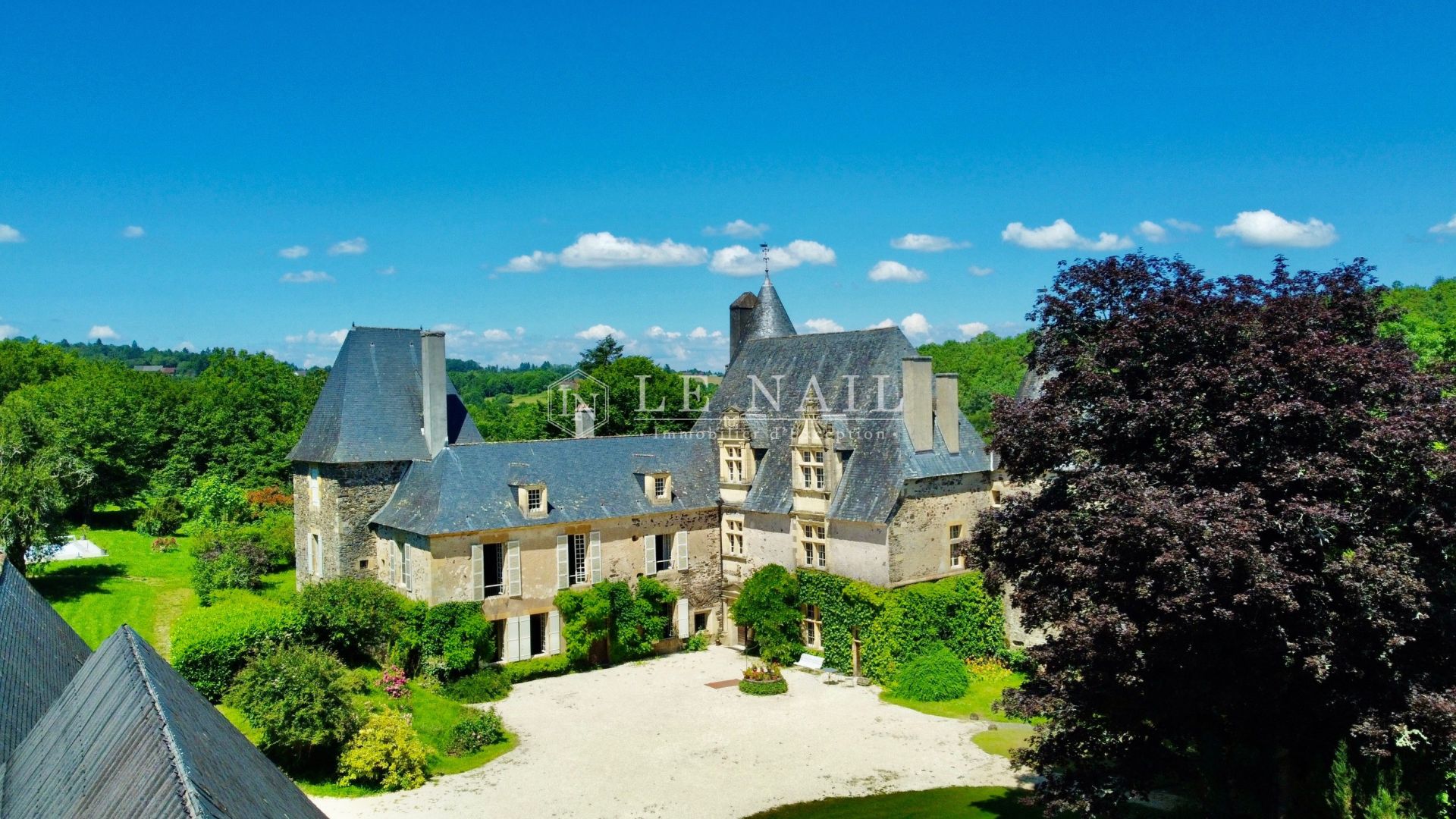

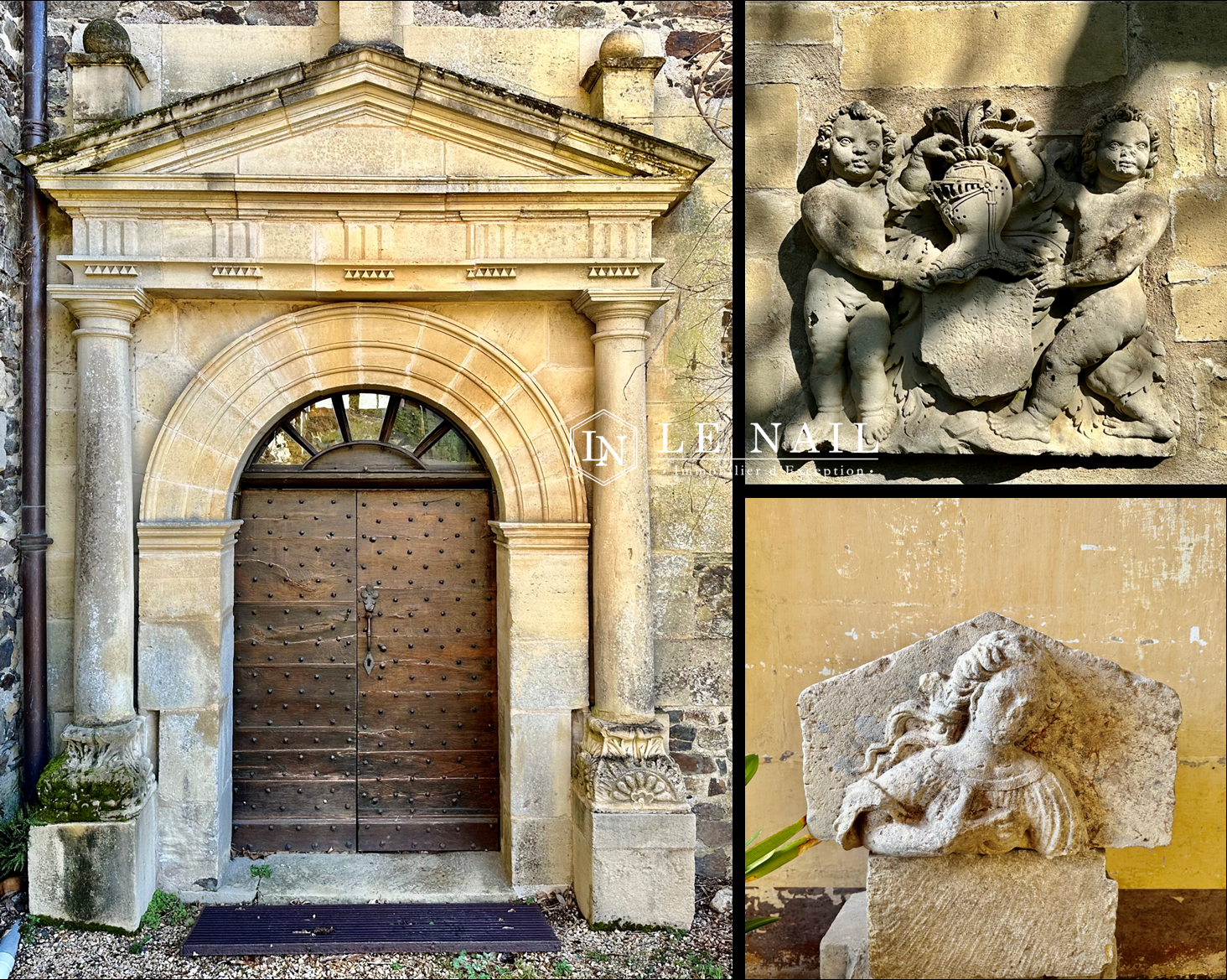

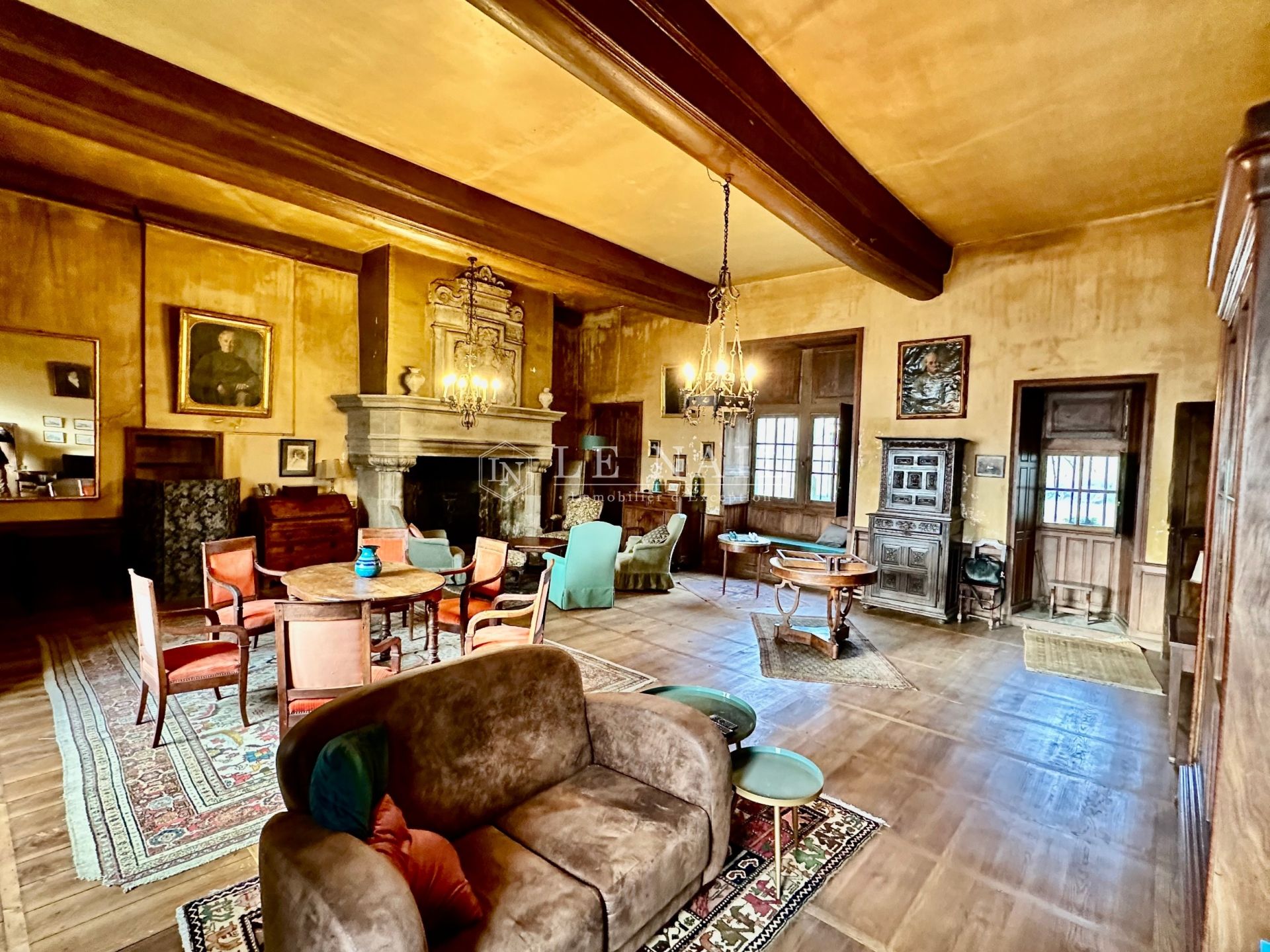

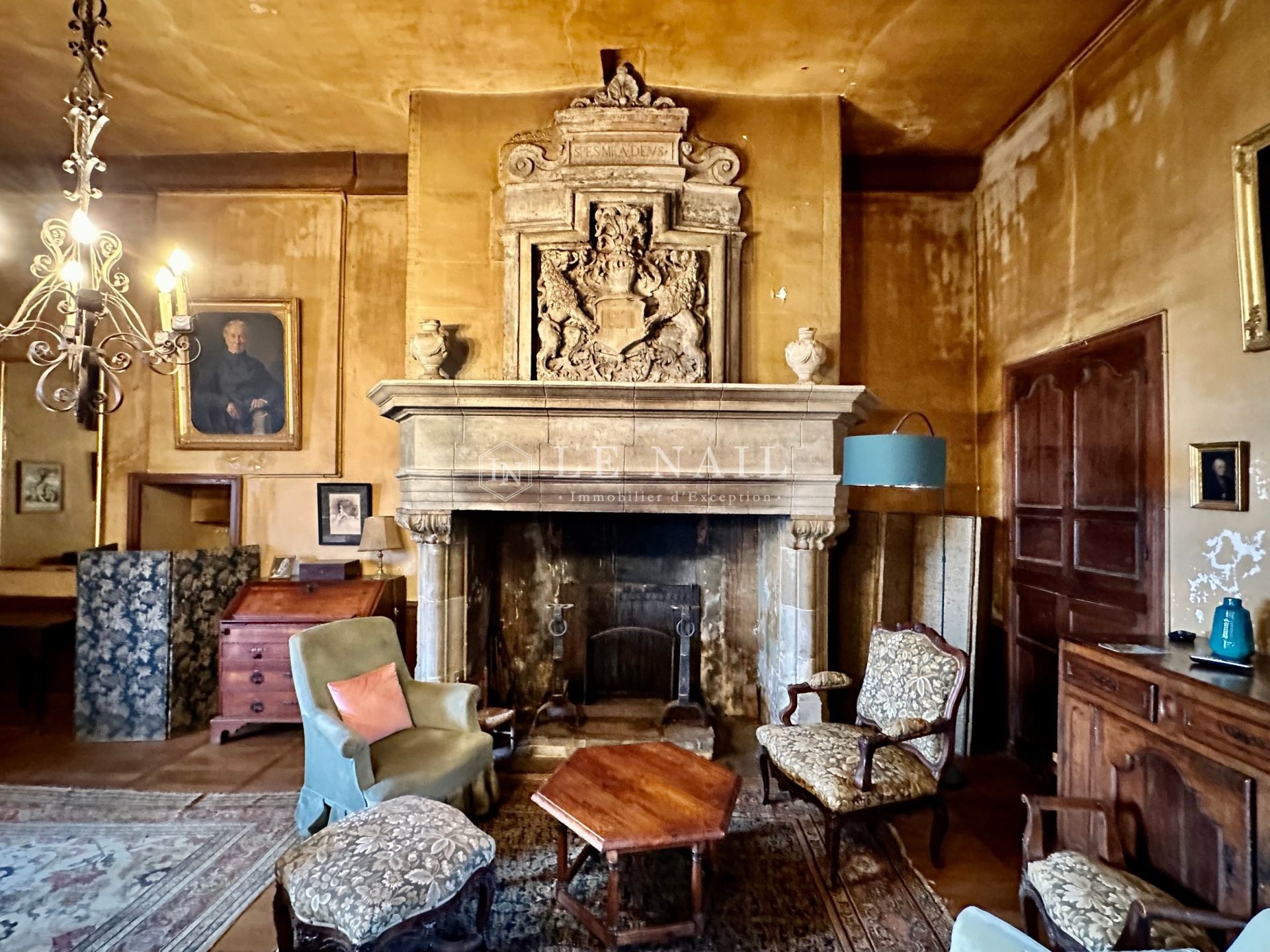

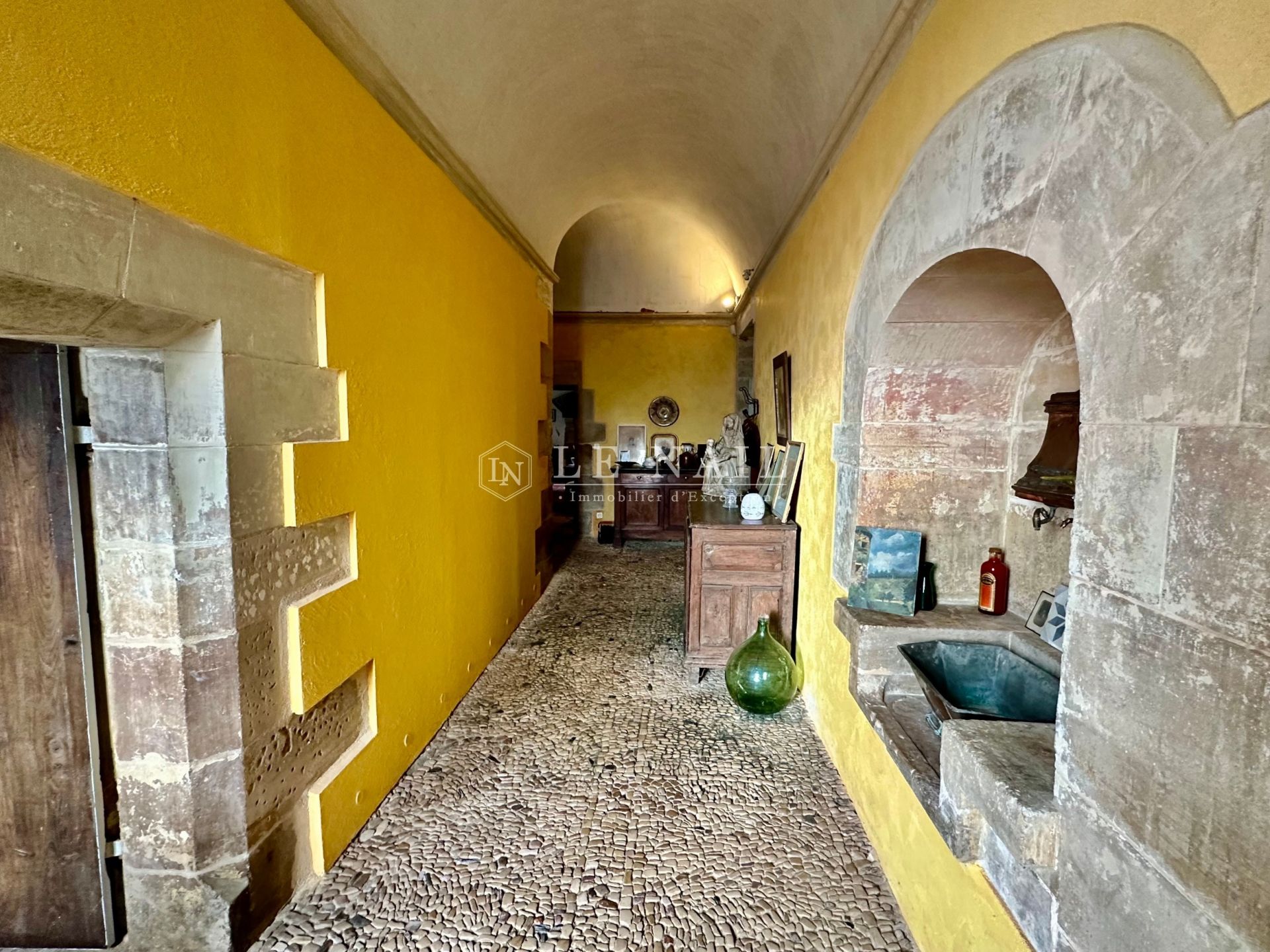

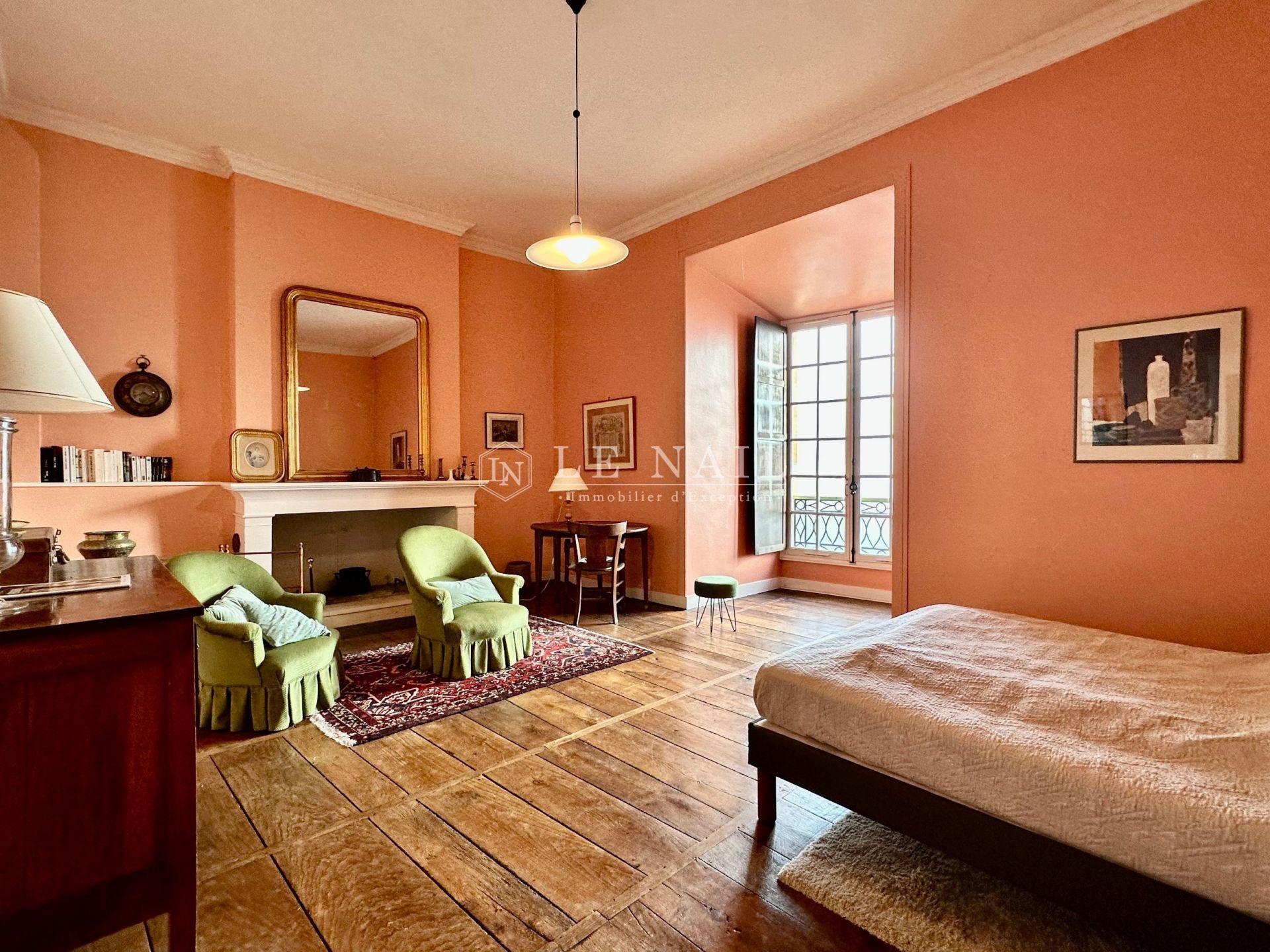

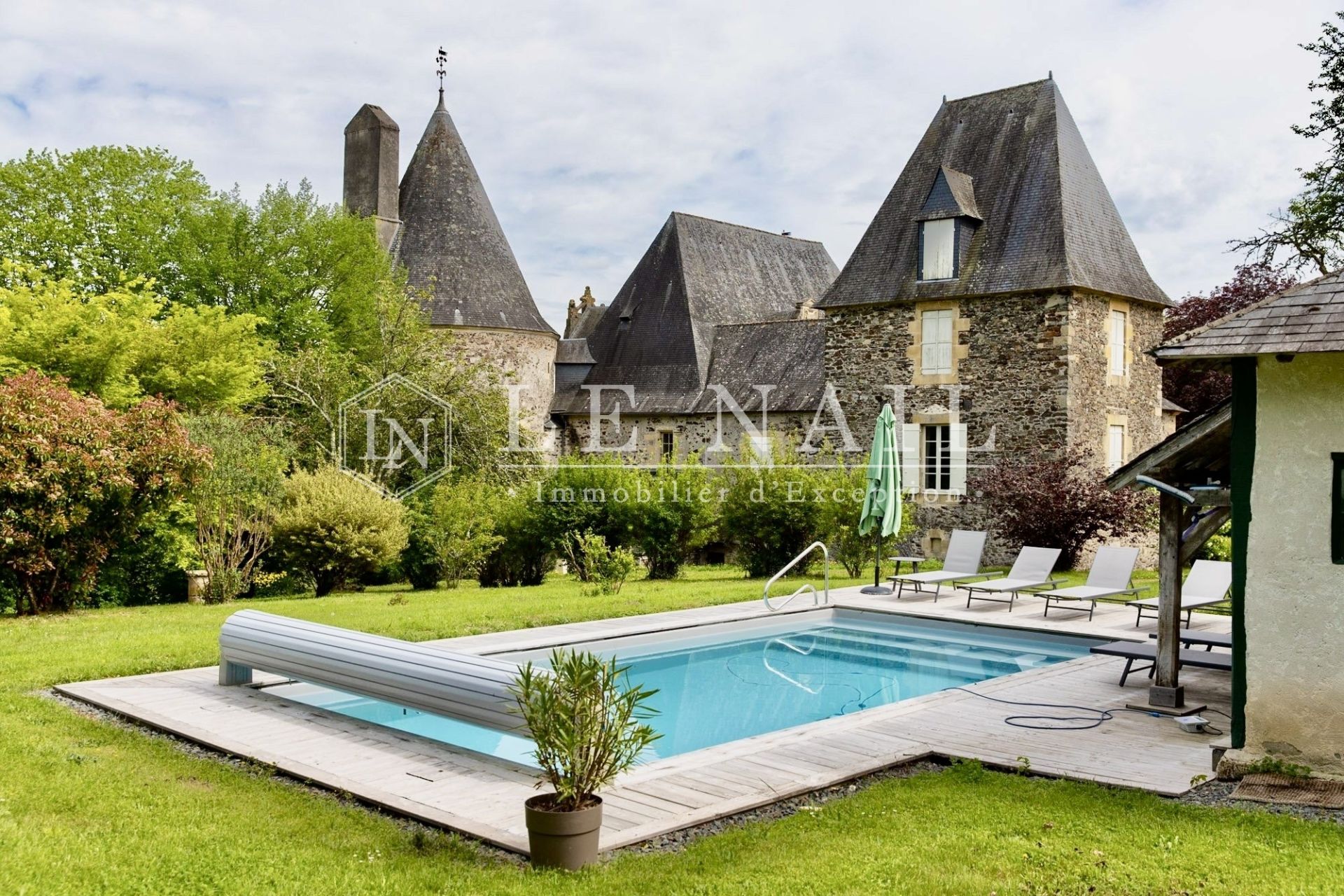

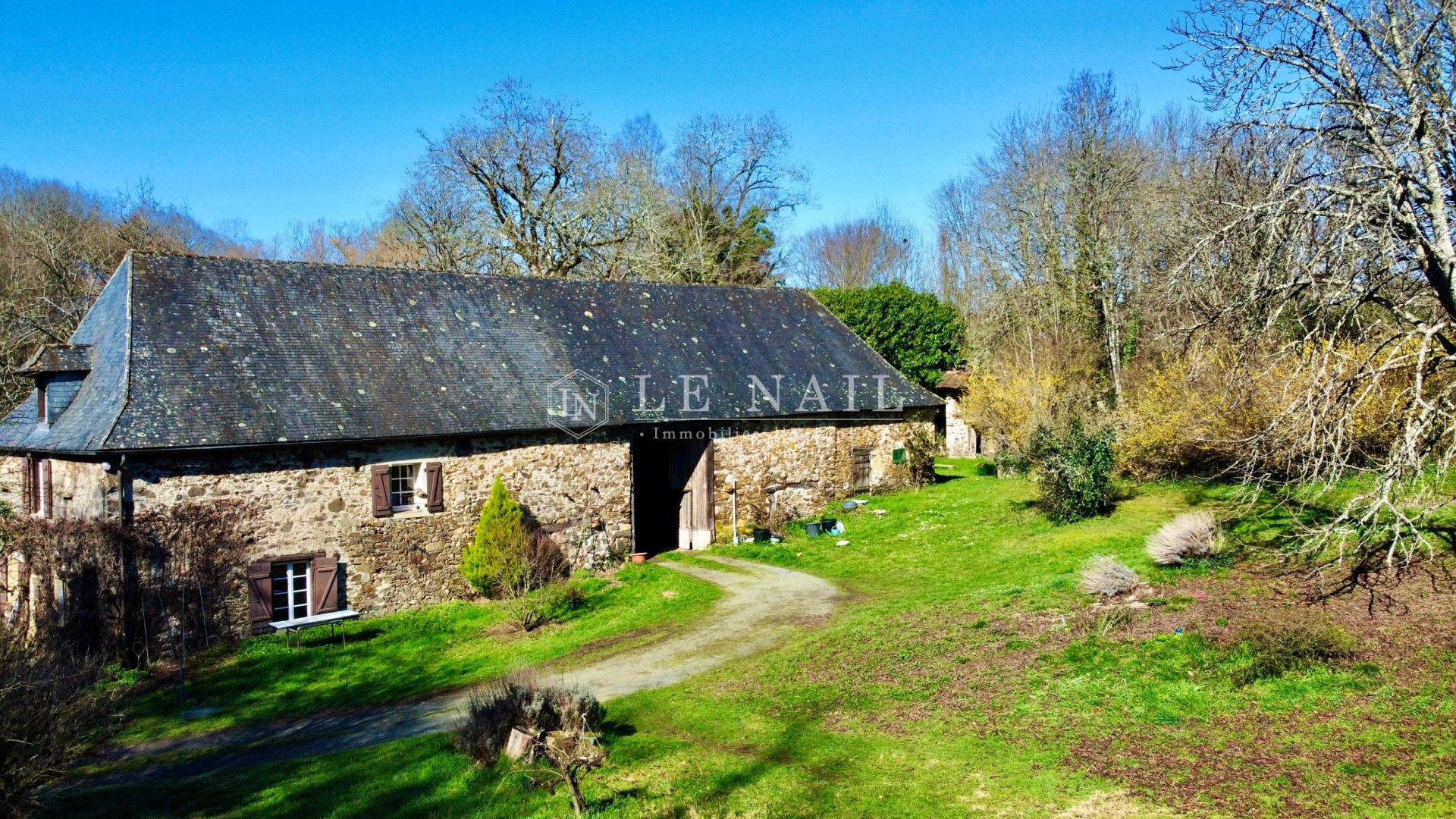

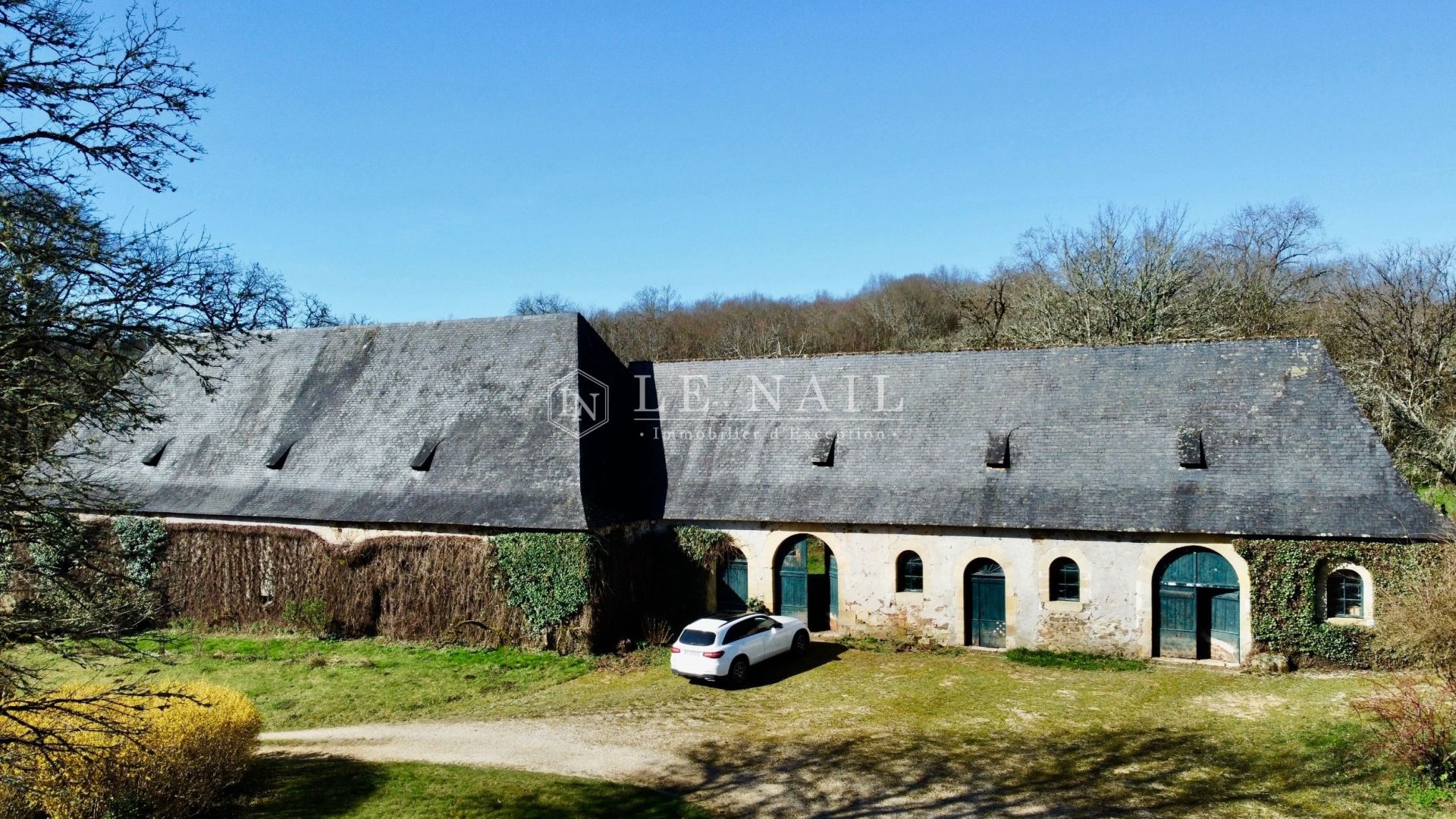

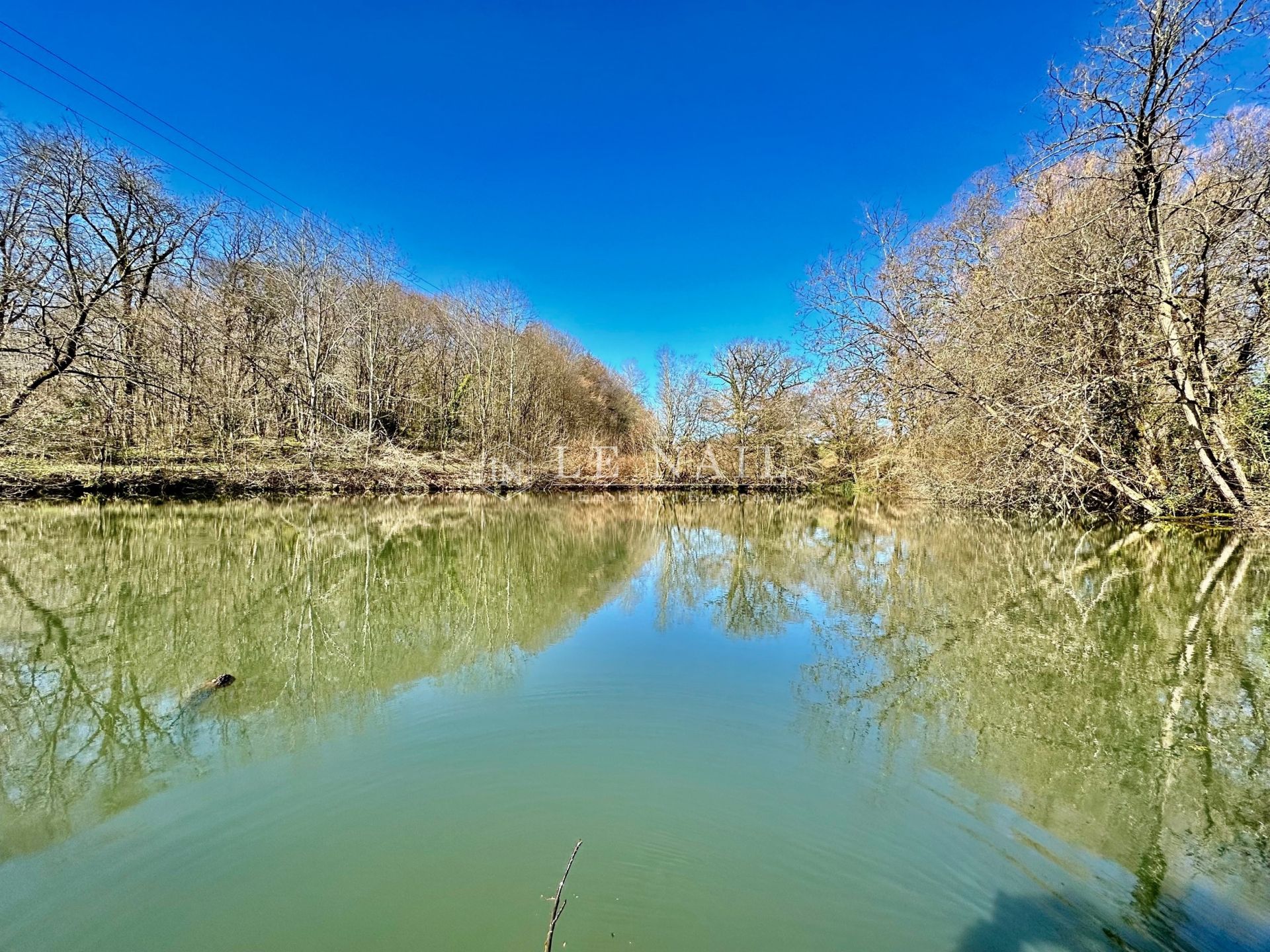

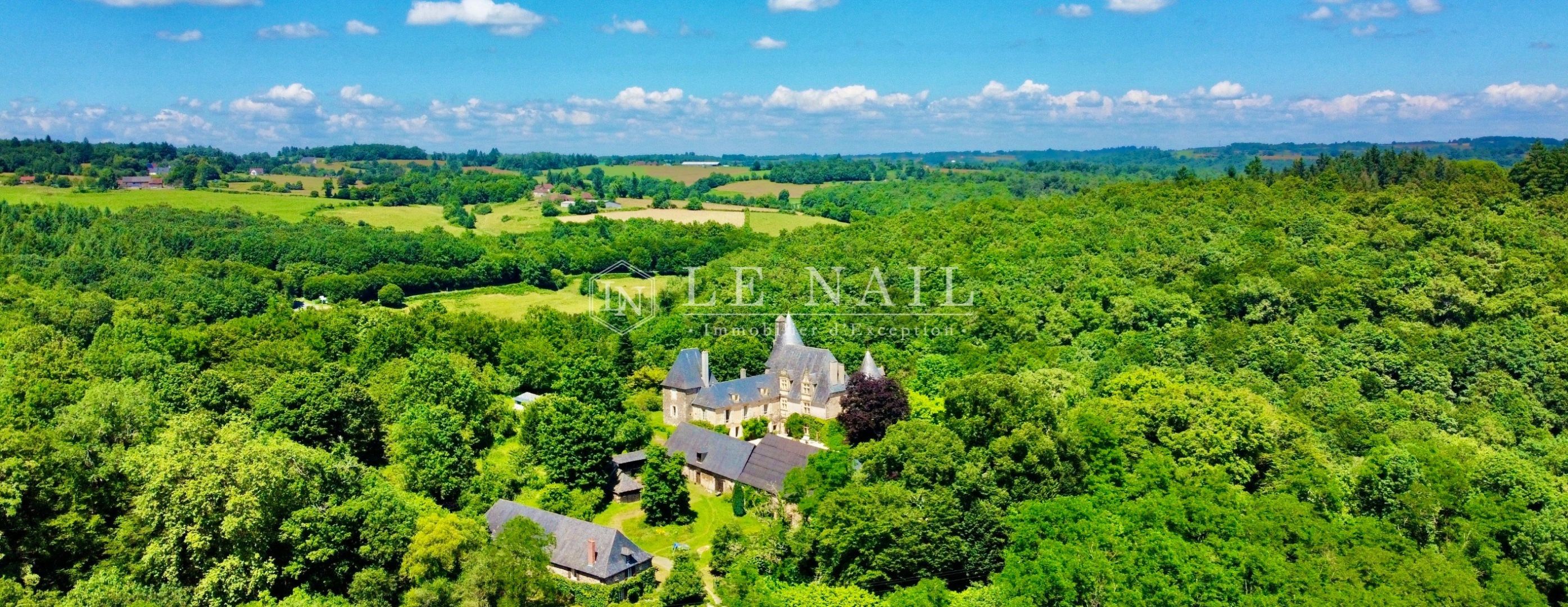
-
Magnificient 15th & 18th c. listed castle, in Dordogne, for sale
- PERIGUEUX (24000)
- 1,550,000 €
- Agency fees chargeable to the seller
- Ref. : 4278
Ref. 4278 : Magnificient 15th & 18th c. listed castle, for sale, in Dordogne
This magnificent chateau dates back to the 14th century and is located in the Dordogne, between Brive and Périgueux.
Nestling on a hillside overlooking the River Auvézère, it enjoys a beautiful, peaceful setting. The property spans more than 29 acres of parklands and gardens, woods, a pond and numerous buildings (caretaker's cottage, barn, stables and henhouse ....).
Originally, this area probably housed a fortified house, built to watch over and protect the ford crossings between the Limousin and Périgord regions. At the end of the Hundred Years' War (1337-1453), this fortification lost its raison d'être. In 1521, Pascal Dolce, a native of Béarn, set up a forge along the Auvézère, near the now obsolete fortifications. Under the management of his successor, Noël Souvelin, the forge prospered. Souvelin probably obtained the concession for the old, abandoned fortification and undertook extensive work to transform it into a residence. His daughter Marguerite married François Pasquet, a merchant from Excideuil, in 1539. The Pasquet family then took charge of the castle and forge for several generations. Jean Pasquet, their eldest son, served Kings Henry III and Henry IV as a knight. His imprint is visible throughout the castle and garden, whether through his motto ("Spes mea deus") or his representation as the "Knight with the white feather". In 1656, following a marriage, the castle and forge came under the ownership of the de Lubersac family. During the French Revolution, the château was abandoned and became national property. It wasn't until 1819 that Louis Combescot, ancestor of the current owner and master blacksmith at the Bord ponds, bought the forge and the château, both of which were in an advanced state of disrepair.He and his descendants set about clearing away the irreparable ruins resulting from decades of neglect.The family moved into the château, and the forge remained in operation for over a century, until the last iron was poured from the blast furnace in 1930.
In its current structure, the château comprises a central main building, set between two round towers, and a wing set at right angles to this building. The large courtyard and the parkland that extends from it are bounded to the west by the buildings used as outbuildings. The west facade of the main building features mullioned windows on both floors and two dormer windows opening into the attic; these dormer windows are topped by pediments with solid tympanums.
The angled south-facing building dates from the 17th and 18th centuries but was rebuilt on earlier foundations.
Behind this wing, a square pavilion was added in the 19th century, blending in with the rest of the building. On the east facade, overlooking the river and the forge, the two towers of unequal diameter were probably originally linked by a curtain wall. As on the west facade, the main building between them features mullioned windows and dormer windows with ornate pediments. The architectural load of the junction between the north tower and the main building is supported by a horn, in the hollow of which is nestled a sculpture representing the tortured face of a figure wearing a draped headdress. The Renaissance gateway, which has been rebuilt in the grounds, symbolises the Italianate style of the late 16th century with its many sculptures. A cartouche in the centre of the entablature bears the castle's motto "SPES MEA DEUS". The château has been listed as a Historic Monument since 1979, and is closely linked to the forge, whose origins probably date back to the end of the Hundred Years' War. It was built between the 14th and 16th centuries and comprises a main building flanked by two cylindrical towers. On the façade of the main building, a beautiful Renaissance door framed by two columns supporting a triangular pediment opens onto a straight barrel-vaulted staircase. The current owners' dwelling is set at right-angles to the house and faces north/south over three floors.
Built on an earthwork and cellar for the towers, the castle spans approx. 640 sqm of living space and comprises :
For the east/west-facing wing:
Ground floor with 4 m high ceilings:
-An entrance hall and a vast lounge with exposed beams and monumental stone fireplace, parquet flooring.
-A study in the tower giving access to the château's dungeons.
An adobe corridor leading to a beautiful stone staircase and a toilet. Fully renovated kitchen. A dining room in the second tower, with large windows.
First floor:
-A corridor leading to a toilet and a shower room,
-6 bedrooms, one with exposed beams and carved stars.
Second floor: Convertible attic with a magnificent roof frame.
For the north/south-facing wing:
Ground floor:
-Entrance hall, kitchen, sitting room.
First floor:
-Hallway communicating with the east wing and leading to a vestibule. 4 bedrooms. Study. Shower room.
Second floor : convertible attic.
The various outbuildings, such as the stable, the barn, the henhouse and the pigsty, form a courtyard that is divided up as follows:
-A caretaker's cottage of approx. 150 sqm, built as an extension to the barn (185 sqm) and situated at the entrance to the property. It has an attractive roof frame and a slate roof.
-An old pigsty and henhouse in need of some work.
-A long building comprising two barns measuring 185 sqm and 300 sqm, currently used for storage, but which could be used for receptions such as weddings, exhibitions, etc. A study has been carried out for this purpose.
-A swimming pool area with a pool house, kitchen and equipment room. The swimming pool, measuring 4x8m, was built in 2018 and equipped with a chlorine filtration system and automatic cover.
The property is surrounded by more than 29.65 acres, as follows:
-4.20 acres of parkland planted with a variety of trees, including magnolias,
walnut and hornbeam. It is enclosed by walls and accessible via two entrances.
-Outside the walls, the owners benefit from a pretty pond with a registered surface area of 3,880 sqm, fed by a spring.
-To complete the surface area of the land and woods, they are located around the château, providing a comfortable private space.
The château was listed as Historic Monument by decree on December, 28th 1979 : Façades and roofs of the château as well as the gate in the park and the forge complex (cadx AC 63, 65, 67)
The chateau is listed on the Inventaire supplémentaire des Monuments Historiques : Interiors of the château itself: facades and roofs of the farmhouse and outbuildings (cadx AC 62, 63): listed by order of August, 29th 1984
This property is registred on the additionnal inventory of historic monuments (allowing fiscal tax cuts if you pay taxes in France).
Cabinet LE NAIL – Dordogne - Périgord - Lot-et-Garonne : M. Bruno GUÉRIN : +33(0)2.43.98.20.20
We invite you to visit our website Cabinet Le Nail to browse our latest listings or learn more about this property.
Information on the risks to which this property is exposed is available at: www.georisques.gouv.fr
-
Magnificient 15th & 18th c. listed castle, in Dordogne, for sale
- PERIGUEUX (24000)
- 1,550,000 €
- Agency fees chargeable to the seller
- Ref. : 4278
- Property type : castle
- Surface : 640 m²
- Surface : 12.1 ha
- Number of rooms : 17
- Number of bedrooms : 10
- Swimming pool : Yes
Energy diagnostics :
Ref. 4278 : Magnificient 15th & 18th c. listed castle, for sale, in Dordogne
This magnificent chateau dates back to the 14th century and is located in the Dordogne, between Brive and Périgueux.
Nestling on a hillside overlooking the River Auvézère, it enjoys a beautiful, peaceful setting. The property spans more than 29 acres of parklands and gardens, woods, a pond and numerous buildings (caretaker's cottage, barn, stables and henhouse ....).
Originally, this area probably housed a fortified house, built to watch over and protect the ford crossings between the Limousin and Périgord regions. At the end of the Hundred Years' War (1337-1453), this fortification lost its raison d'être. In 1521, Pascal Dolce, a native of Béarn, set up a forge along the Auvézère, near the now obsolete fortifications. Under the management of his successor, Noël Souvelin, the forge prospered. Souvelin probably obtained the concession for the old, abandoned fortification and undertook extensive work to transform it into a residence. His daughter Marguerite married François Pasquet, a merchant from Excideuil, in 1539. The Pasquet family then took charge of the castle and forge for several generations. Jean Pasquet, their eldest son, served Kings Henry III and Henry IV as a knight. His imprint is visible throughout the castle and garden, whether through his motto ("Spes mea deus") or his representation as the "Knight with the white feather". In 1656, following a marriage, the castle and forge came under the ownership of the de Lubersac family. During the French Revolution, the château was abandoned and became national property. It wasn't until 1819 that Louis Combescot, ancestor of the current owner and master blacksmith at the Bord ponds, bought the forge and the château, both of which were in an advanced state of disrepair.He and his descendants set about clearing away the irreparable ruins resulting from decades of neglect.The family moved into the château, and the forge remained in operation for over a century, until the last iron was poured from the blast furnace in 1930.
In its current structure, the château comprises a central main building, set between two round towers, and a wing set at right angles to this building. The large courtyard and the parkland that extends from it are bounded to the west by the buildings used as outbuildings. The west facade of the main building features mullioned windows on both floors and two dormer windows opening into the attic; these dormer windows are topped by pediments with solid tympanums.
The angled south-facing building dates from the 17th and 18th centuries but was rebuilt on earlier foundations.
Behind this wing, a square pavilion was added in the 19th century, blending in with the rest of the building. On the east facade, overlooking the river and the forge, the two towers of unequal diameter were probably originally linked by a curtain wall. As on the west facade, the main building between them features mullioned windows and dormer windows with ornate pediments. The architectural load of the junction between the north tower and the main building is supported by a horn, in the hollow of which is nestled a sculpture representing the tortured face of a figure wearing a draped headdress. The Renaissance gateway, which has been rebuilt in the grounds, symbolises the Italianate style of the late 16th century with its many sculptures. A cartouche in the centre of the entablature bears the castle's motto "SPES MEA DEUS". The château has been listed as a Historic Monument since 1979, and is closely linked to the forge, whose origins probably date back to the end of the Hundred Years' War. It was built between the 14th and 16th centuries and comprises a main building flanked by two cylindrical towers. On the façade of the main building, a beautiful Renaissance door framed by two columns supporting a triangular pediment opens onto a straight barrel-vaulted staircase. The current owners' dwelling is set at right-angles to the house and faces north/south over three floors.
Built on an earthwork and cellar for the towers, the castle spans approx. 640 sqm of living space and comprises :
For the east/west-facing wing:
Ground floor with 4 m high ceilings:
-An entrance hall and a vast lounge with exposed beams and monumental stone fireplace, parquet flooring.
-A study in the tower giving access to the château's dungeons.
An adobe corridor leading to a beautiful stone staircase and a toilet. Fully renovated kitchen. A dining room in the second tower, with large windows.
First floor:
-A corridor leading to a toilet and a shower room,
-6 bedrooms, one with exposed beams and carved stars.
Second floor: Convertible attic with a magnificent roof frame.
For the north/south-facing wing:
Ground floor:
-Entrance hall, kitchen, sitting room.
First floor:
-Hallway communicating with the east wing and leading to a vestibule. 4 bedrooms. Study. Shower room.
Second floor : convertible attic.
The various outbuildings, such as the stable, the barn, the henhouse and the pigsty, form a courtyard that is divided up as follows:
-A caretaker's cottage of approx. 150 sqm, built as an extension to the barn (185 sqm) and situated at the entrance to the property. It has an attractive roof frame and a slate roof.
-An old pigsty and henhouse in need of some work.
-A long building comprising two barns measuring 185 sqm and 300 sqm, currently used for storage, but which could be used for receptions such as weddings, exhibitions, etc. A study has been carried out for this purpose.
-A swimming pool area with a pool house, kitchen and equipment room. The swimming pool, measuring 4x8m, was built in 2018 and equipped with a chlorine filtration system and automatic cover.
The property is surrounded by more than 29.65 acres, as follows:
-4.20 acres of parkland planted with a variety of trees, including magnolias,
walnut and hornbeam. It is enclosed by walls and accessible via two entrances.
-Outside the walls, the owners benefit from a pretty pond with a registered surface area of 3,880 sqm, fed by a spring.
-To complete the surface area of the land and woods, they are located around the château, providing a comfortable private space.
The château was listed as Historic Monument by decree on December, 28th 1979 : Façades and roofs of the château as well as the gate in the park and the forge complex (cadx AC 63, 65, 67)
The chateau is listed on the Inventaire supplémentaire des Monuments Historiques : Interiors of the château itself: facades and roofs of the farmhouse and outbuildings (cadx AC 62, 63): listed by order of August, 29th 1984
This property is registred on the additionnal inventory of historic monuments (allowing fiscal tax cuts if you pay taxes in France).
Cabinet LE NAIL – Dordogne - Périgord - Lot-et-Garonne : M. Bruno GUÉRIN : +33(0)2.43.98.20.20
We invite you to visit our website Cabinet Le Nail to browse our latest listings or learn more about this property.
Information on the risks to which this property is exposed is available at: www.georisques.gouv.fr
Contact
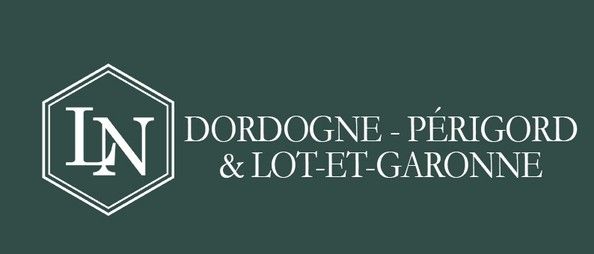
- Mr Bruno GUÉRIN

